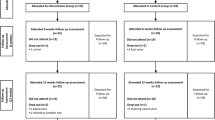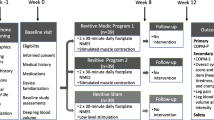Abstract
Background
Impaired mobility is a debilitating consequence of hemodialysis. We examined the efficacy of intradialytic-plantar-electrical-nerve-stimulation (iPENS) to promote mobility among diabetes patients undergoing hemodialysis..
Methods
Adults with diabetes undergoing hemodialysis received either 1-h active iPENS, (Intervention-Group) or non-functional iPENS (Control-Group) during routine hemodialysis for 12 weeks (3 sessions/week). Participants and care-providers were blinded. Mobility (assessed using a validated pendant-sensor) and neuropathy (quantified by vibration-perception-threshold test) outcomes were assessed at baseline and 12 weeks.
Results
Among 77 enrolled subjects (56.2 ± 2.6 years old), 39 were randomly assigned to the intervention group, while 38 were assigned to the control group. No study-related adverse events and dropouts were reported in the intervention group. Compared to the control group, significant improvements with medium to large effect sizes were observed in the intervention group at 12 weeks for mobility-performance metrics, including active-behavior, sedentary-behavior, daily step counts, and sit-to-stand duration variability (p < 0.05), Cohen’s d effect size (d = 0.63–0.84). The magnitude of improvement in active-behavior was correlated with improvement in the vibration-perception-threshold test in the intervention group (r = − 0.33, p = 0.048). A subgroup with severe-neuropathy (vibration-perception-threshold > 25 V) showed a significant reduction in plantar numbness at 12 weeks compared to baseline (p = 0.03, d = 1.1).
Conclusions
This study supports feasibility, acceptability, and effectiveness of iPENS to improve mobility and potentially reduce plantar numbness in people with diabetes undergoing hemodialysis. Considering that exercise programs are not widely used in hemodialysis clinical practice, iPENS may serve as a practical, alternative solution to reduce hemodialysis-acquired weakness and promote mobility.
Graphical Abstract




Similar content being viewed by others
Data availability
The data supporting this study's findings are available upon request. The authors understand the importance of data transparency and are committed to promoting scientific reproducibility. However, the data cannot be publicly available due to ethical and privacy considerations. Researchers interested in accessing the data may request the necessary information from the corresponding author.
Abbreviations
- CKD:
-
Chronic kidney disease
- DPN:
-
Diabetic peripheral neuropathy
- HD:
-
Hemodialysis
- iPENS:
-
Intradialytic plantar electrical stimulation
- VEGF:
-
Vascular endothelial growth factor
- VPT:
-
Vibration perception threshold
References
Najafi B, Talal TK, Grewal GS, Menzies R, Armstrong DG, Lavery LA (2017) Using plantar electrical stimulation to improve postural balance and plantar sensation among patients with diabetic peripheral neuropathy: a randomized double blinded study. J Diabetes Sci Technol 11(4):693–701
Moreno JP, Razjouyan J, Lester H, Dadabhoy H, Amirmazaheri M, Reesor-Oyer L et al (2021) Later sleep timing predicts accelerated summer weight gain among elementary school children: a prospective observational study. Int J Behav Nutr Phys Act 18(1):94
Luyckx VA, Tonelli M, Stanifer JW (2018) The global burden of kidney disease and the sustainable development goals. Bull World Health Organ 96(6):414
Valenzuela PL, Morales JS, Ruilope LM, de la Villa P, Santos-Lozano A, Lucia A (2020) Intradialytic neuromuscular electrical stimulation improves functional capacity and muscle strength in people receiving haemodialysis: a systematic review. J Physiother 66(2):89–96
Mishra RK, Al-Ali F, Hamad A, Ibrahim R, Mathew M, Najafi B (2021) MO623 effect of plantar electrical nerve stimulation during routine hemodialysis process on the daily physical activity in adults with diabetes and end-stage renal disease—a randomized double-blinded controlled trial. Nephrol Dial Transplant 36(Supplement_1):gfab093 (04)
Mishra RK, Bara RO, Zulbaran-Rojas A, Park C, Fernando ME, Ross J et al (2022) The application of digital frailty screening to triage nonhealing and complex wounds. J Diabet Sci Technol 19322968221111194
Carrero JJ, Stenvinkel P, Cuppari L, Ikizler TA, Kalantar-Zadeh K, Kaysen G et al (2013) Etiology of the protein-energy wasting syndrome in chronic kidney disease: a consensus statement from the International Society of Renal Nutrition and Metabolism (ISRNM). J Ren Nutr 23(2):77–90
Marcelli D, Brand K, Ponce P, Milkowski A, Marelli C, Ok E et al (2016) Longitudinal changes in body composition in patients after initiation of hemodialysis therapy: results from an international cohort. J Ren Nutr 26(2):72–80
Hendriks FK, Smeets JS, Broers NJ, van Kranenburg JM, van der Sande FM, Kooman JP et al (2020) End-stage renal disease patients lose a substantial amount of amino acids during hemodialysis. J Nutr 150(5):1160–1166
Huang M, Lv A, Wang J, Xu N, Ma G, Zhai Z et al (2019) Exercise training and outcomes in hemodialysis patients: systematic review and meta-analysis. Am J Nephrol 50(4):240–254
Deligiannis A, D’Alessandro C, Cupisti A (2021) Exercise training in dialysis patients: impact on cardiovascular and skeletal muscle health. Clin Kidney J 14(Supplement_2):ii25–ii33
Najafi B, Crews RT, Wrobel JS (2013) A novel plantar stimulation technology for improving protective sensation and postural control in patients with diabetic peripheral neuropathy: a double-blinded, randomized study. Gerontology 59(5):473–480
Thakral G, Kim PJ, LaFontaine J, Menzies R, Najafi B, Lavery LA (2013) Electrical stimulation as an adjunctive treatment of painful and sensory diabetic neuropathy. J Diabetes Sci Technol 7(5):1202–1209
Donato B, Teixeira C, Velho S, Almeida E (2021) Sarcopenia in chronic kidney disease—a brief review. Port J Nephrol Hypert 35(2):99–105
Thakral G, LaFontaine J, Najafi B, Talal TK, Kim P, Lavery LA (2013) Electrical stimulation to accelerate wound healing. Diabet Foot Ankle 4(1):22081
Simó VE, Jiménez AJ, Oliveira JC, Guzmán FM, Nicolás MF, Potau MP et al (2015) Efficacy of neuromuscular electrostimulation intervention to improve physical function in haemodialysis patients. Int Urol Nephrol 47(10):1709–1717
Schardong J, Dipp T, Bozzeto CB, da Silva MG, Baldissera GL, Ribeiro RC et al (2017) Effects of intradialytic neuromuscular electrical stimulation on strength and muscle architecture in patients with chronic kidney failure: randomized clinical trial. Artif Organs 41(11):1049–1058
AVAZZIA (2023) ‘AVAZZIA Reaction Technology for Medical Therapies’. https://avazzia.com/. Accessed 15 May 2023
Assimon MM, Wenger JB, Wang L, Flythe JE (2016) Ultrafiltration rate and mortality in maintenance hemodialysis patients. Am J Kidney Dis 68(6):911–922
Lee Y-J, Okuda Y, Sy J, Lee YK, Obi Y, Cho S et al (2020) Ultrafiltration rate, residual kidney function, and survival among patients treated with reduced-frequency hemodialysis. Am J Kidney Dis 75(3):342–350
Mishra R, Park C, York MK, Kunik ME, Wung S-F, Naik AD et al (2021) Decrease in mobility during the COVID-19 pandemic and its association with increase in depression among older adults: a longitudinal remote mobility monitoring using a wearable sensor. Sensors 21(9):3090
Sheehan TJ, Fifield J, Reisine S, Tennen H (1995) The measurement structure of the Center for Epidemiologic Studies Depression scale. J Pers Assess 64(3):507–521
Tiffin-Richards FE, Costa AS, Holschbach B, Frank RD, Vassiliadou A, Krüger T et al (2014) The Montreal Cognitive Assessment (MoCA)-a sensitive screening instrument for detecting cognitive impairment in chronic hemodialysis patients. PLoS One 9(10):e106700
Galvão MH, Santos LIS, Barcelar JM, Marinho PEM (2013) Assessment of the capacity of the Falls Efficacy Scale International in specifying the risk of falling in patients with chronic kidney disease on hemodialysis. Fisioterapia e Pesquisa 20:151–157
Alradaydeh MF, Khalil AA (2018) The association of spiritual well-being and depression among patients receiving hemodialysis. Perspect Psychiatr Care 54(3):341–347
Shimoda T, Matsuzawa R, Yoneki K, Harada M, Watanabe T, Matsumoto M et al (2017) Changes in physical activity and risk of all-cause mortality in patients on maintence hemodialysis: a retrospective cohort study. BMC Nephrol 18(1):1–8
Bosi E, Conti M, Vermigli C, Cazzetta G, Peretti E, Cordoni M et al (2005) Effectiveness of frequency-modulated electromagnetic neural stimulation in the treatment of painful diabetic neuropathy. Diabetologia 48(5):817–823
Malik R, Newrick P, Sharma A, Jennings A, Ah-See A, Mayhew T et al (1989) Microangiopathy in human diabetic neuropathy: relationship between capillary abnormalities and the severity of neuropathy. Diabetologia 32(2):92–102
Schratzberger P, Schratzberger G, Silver M, Curry C, Kearney M, Magner M et al (2000) Favorable effect of VEGF gene transfer on ischemic peripheral neuropathy. Nat Med 6(4):405–413
Aucella F, Gesuete A, Battaglia Y (2014) A “nephrological” approach to physical activity. Kidney Blood Press Res 39(2–3):189–196
Grewal GS, Schwenk M, Lee-Eng J, Parvaneh S, Bharara M, Menzies RA et al (2015) Sensor-based interactive balance training with visual joint movement feedback for improving postural stability in diabetics with peripheral neuropathy: a randomized controlled trial. Gerontology 61(6):567–574
Acknowledgements
We wish to thank Naima Rodriguez, Anmol Momin, and Maria Noun, who contributed in part in data management.
Funding
The project described was supported by a grant from the Qatar National Research Foundation, QNRF, (Award Numbers NPRP 10-0208-170400, http://www.qnrf.org/) and in-kind support from Hamad Medical Corporation, HMC (Doha, Qatar). The content is solely the responsibility of the authors and does not necessarily represent the official views of the QNRF or HMC.
Author information
Authors and Affiliations
Contributions
RM performed the statistical analysis, interpretation of data, drafting of the original manuscript, and critical revision of the manuscript for important intellectual content. RI and MM were involved in data collection and critical revision of the manuscript. RB, ML, FAA, AH, and TT contributed to the data interpretation and critical revision of the manuscript for important intellectual content. BN, FAA, AH, and TT contributed to the study concept and design, critical revision of the manuscript for important intellectual content, and securing funding.
Corresponding author
Ethics declarations
Conflict of interest
None of the authors declared conflict of interest relevant to the scope of this study.
Ethical statement
This study received approval from the local Institutional Review Board (IRB) at Hamad Medical Corporation, under protocol number MRC 03-17-0010.
Additional information
Publisher's Note
Springer Nature remains neutral with regard to jurisdictional claims in published maps and institutional affiliations.
Rights and permissions
Springer Nature or its licensor (e.g. a society or other partner) holds exclusive rights to this article under a publishing agreement with the author(s) or other rightsholder(s); author self-archiving of the accepted manuscript version of this article is solely governed by the terms of such publishing agreement and applicable law.
About this article
Cite this article
Mishra, R.K., Najafi, B., Hamad, A. et al. Intradialytic plantar electrical nerve stimulation to improve mobility and plantar sensation among adults with diabetes undergoing hemodialysis: a randomized double-blind trial. J Nephrol 36, 1627–1637 (2023). https://doi.org/10.1007/s40620-023-01625-9
Received:
Accepted:
Published:
Issue Date:
DOI: https://doi.org/10.1007/s40620-023-01625-9




